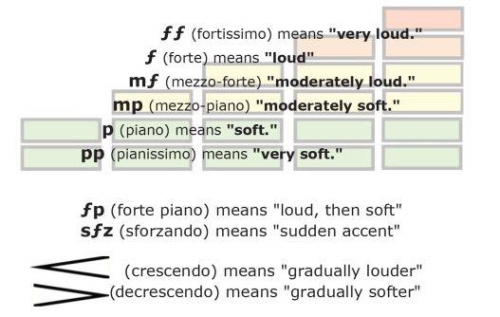Are you tired of not being able to write songs that truly express your ideas? Do you wish you could effortlessly write great music that sounds like the kind made by your favorite musicians? It's a fact that you will need to practice songwriting on a consistent basis in order to become 'highly' expressive as a songwriter. However, it does not necessarily have to take you a very long time to gain the skills needed to accurately express yourself through music.
One of the biggest reasons why many musicians take a long time to become expressive songwriters is they ignore one or more important elements in music. In this article, I will discuss one of the most overlooked musical elements, why most musicians ignore it and how you can use it to better express yourself in music. The musical element I will cover is the element of dynamics.
WARNING: If you read the last sentence and thought to yourself: "Dynamics? I already know what that is writing music loud and soft. Tell me something I don't know!" You have already made the same mistake that most songwriters make! So many musicians approach songwriting by trying to come up with new chords, melodies or rhythms and totally 'ignore' dynamics. This is very unfortunate because by ignoring dynamics, you are ignoring one of the most useful elements for expressing yourself in music. Before I begin discussing this element in depth, I'd like you to understand how learning more about it will be beneficial to your songwriting. Here are 3 things that will happen when you learn to creatively use dynamics in your music:
When it comes to dynamics most people understand this to describe the general volume level of a song. However, dynamics refers to both overall volume of the music as well as the individual parts that make up the music as a whole. Whenever you read a piece of music, you will see various letters that are used to display the dynamics. These have been developed and changed over a span of centuries until arriving at the letters we have today. Here are a few examples:

By using contrasting dynamics you can quickly grab the attention of anyone listening to your music. For example, think about the common songwriting formula used in rock ballads. For the most part, the song will consist of softly played acoustic guitar and vocal parts. Many times, the introduction (and beginning verse and chorus) will contain no percussion whatsoever. Then, to provide contrast, the drums will begin playing during the second verse. As an even bigger contrast, the songwriter may even include a solo/break section with electric guitar (only to return to the soft, acoustic guitar parts once the section has ended). This simple formula is highly effective at gaining the attention of the listener due to its contrasting dynamics. You can also use this concept in your music to contrast not only entire song sections, but different notes within a single melody or musical idea.
To make any melody stick out, emphasize it by using varying dynamics. For instance, begin the melody "loud" and gradually reduce the volume until the notes are "soft". This technique is known as a "decrescendo". Additionally, alter the volume level of different notes within a melody to make them contrast with each other and stick out. This is especially useful for adding interest to repeating musical parts in your songs. This will give you the power to express yourself in different ways without altering any of the actual pitches in your melody. Discover more creative ways to create an interesting melody in your songs by reading this free songwriting technique guide.
One of the most creative ways to enhance the effect of dynamics in your songs is to use 'silence' as a tool for creating musical tension and getting the listener's attention. To illustrate this, think about a time when you were listening to loud music in your car when all of a sudden your friend in the passenger seat presses pause on the stereo. Most likely, you would immediately think to yourself something like "Hey, what's going on?!" This exact reaction came be recreated when you use silence in your music to catch the listener off guard and 'force' them to concentrate on the music. To do this, take a part for a song that you have already written and replace various notes with silence. You will find that by doing this you alter the feel of the rhythm and (for longer periods of silence) build up a sense of anticipation. However, also note that silence can easily be overused, so do not overwhelm your listeners or the feeling of surprise that they feel will quickly wear off.
A very underestimated approach that can help you learn how to better express yourself in music is to study the scores of your favorite movies. I don't mean you need to purchase the actual score itself and read the music… but instead simply observe the way the music is arranged with different scenes throughout the film. This will help you equate the emotions expressed by the actors along with the music and build your ability to express yourself better in your songwriting. Here are some common examples:
Think of a romantic scene where a couple is brought together at the airport. First, there is a lot of doubt on both sides about whether the relationship will work out or not (with very soft music playing in the background). After the couple talks for a little bit, they finally come to the decision that they must go their separate ways. Both the man and woman walk off and the scene cuts to the man walking out of the airport thinking of past memories of his lover. Inside the airport, the woman sits with her face in her hands, wondering what will become of her life without the presence of the man she cared for so much. Suddenly, they both have the realization that they were wrong... they will find a way to make things work. They both get up and start running to find one another (the music begins building in volume). They run frantically through the airport, trying to regain the last spec of hope that the other person hasn't left yet, and is looking for them too (music continues becoming louder and louder). Then across a crowd, they lock eyes, run toward each other and embrace! In response, the music climaxes here and is playing at its loudest...
For this scene, visualize a horror setting with a character walking around in the basement of a dark, abandoned mansion by himself with quiet/eerie music playing in the background. The power is out and the character needs to find the circuit breaker to turn it back on. He finds his way to the basement, opens the door and slowly makes his way down the basement steps. As he walks down the decrepit wooden steps, they creek and bend under his feet. In this moment, man senses that he is not alone. "Is anyone there?" he whispers (the music of the scene quickly escalates from quiet to very loud). The man quickly turns his head and looks behind him (music goes silent) … Nothing there. He continues down the stairs and moves his hands along the wall until he finally comes across the finds the circuit breaker. He reaches into his pocket for his lighter. Hands shaking, he fumbles to get it to light and nervously drops it to the floor. Bending down to pick it up, he hears a creek on the stairs. "Who's there?" he says, now in a frightened, demanding tone. After several seconds, the silence in the room is broken as he hears a low incomprehensible growl. The man's eyes glaze over as his adrenaline sky rockets and fear pumps through his veins. The growl gets slowly closer and closer (as the music gets louder, building tension) until suddenly… a horrific scream! Then… silence.
As you have read through this article you have discovered different ways to express yourself through music using dynamics. Keep in mind that dynamics are not only a great tool of expression in movies, but in any musical situation. As you focus on dynamics in your songwriting, remember to use balance in order to create a powerful sensation of tension and release that will keep your listeners on the edge of their seats.
Visualize a scene in a movie like this: It's 11:30AM and there is a businessman standing at a packed street corner waiting for the "walk" sign to turn on so he can cross. All around him you can hear the sounds of the big city such as cars honking, the roar of continuous chatter and street vendors yelling out to attract new customers (you can also hear upbeat music playing in the background to set the scene). Suddenly, the sign turns on and the businessman looks up from his watch as everyone starts crossing the street in a big moving mass - bumping into him along the way. He adjusts his coat and quickly makes his way across the street. As he quickly jogs across he suddenly trips and drops his briefcase... papers go flying everywhere. He falls to the ground, scrambles to pick them up and stuff them into his briefcase as quickly as possible while losing focus of his surroundings. Finally he grabs the last one... "Gotcha!" he says as he crams it inside. Then, as he stands up to dust himself off you hear the loud screech of a car slamming on the breaks as it comes to an instant stop in front of him.
At the end of this scene, what is a good way that the music in the score could emphasize the stress of the situation? In many cases for a scene like this, you will hear the music quickly build up to end on a very loud group of notes. This feels very surprising when compared with the previous musical ideas played in the background and is very expressive of the sudden shock the character might feel.
Become a much more expressive songwriter using dynamics and many other musical elements by studying the ideas in this songwriting technique guide.
Shawn J. Wagner is a semi-professional musician, guitarist and composer.
He has written s number of instructional articles on guitar, songwriting and music theory.
